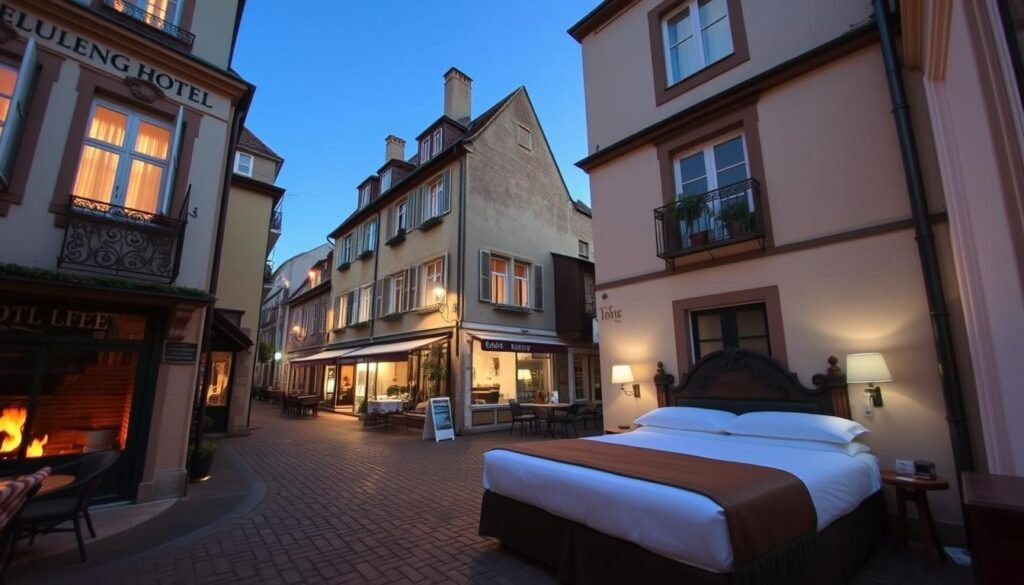Travel on a Budget: Our Favorite Tips and Tricks
Have you ever wondered if you can chase your dream adventure without draining your savings?
We set the stage by sharing how we plan, prioritize, and protect the parts of a trip that mean the most to us. Our approach is practical and friendly, focused on steps that save money while keeping the experience rich.
We map choices from purpose to timing, flights, stays, food, and safety. We point out new 2025 openings like Orlando and timeless moves like off-peak dates that stretch dollars.
Small choices add up: we use tools and communities to stay smart and safe, balance spontaneity with structure, and keep trips fun. This listicle reflects what we actually use so you can adapt tips to your life and dream itineraries.
Key Takeaways
- Define what matters most so savings don’t feel like loss.
- Use timing and tools to unlock big savings for flights and stays.
- Prioritize experiences; cut what doesn’t add value.
- Blend structure with spontaneity for flexible, cheaper plans.
- Leverage communities and up-to-date 2025 opportunities.
Why We Love Budget Travel: Setting the Stage for Affordable Adventure
By focusing on purpose and pace, we make our dollars go farther and our trips mean more.
We choose slower journeys so we can see more of the world over time without financial stress. Slower pace gives us space to meet people, linger at markets, and join community events most visitors miss.
Mindful choices prove that price does not always equal quality. We often get better value by swapping one costly attraction for several free cultural moments.
Flexible planning helps us tap into unique adventures when they appear. Small tweaks to timing and routing save money and unlock unexpected experiences.
“The shift from FOMO to intention made our trips calmer, richer, and far less expensive.”
We do homework before we go so decisions on the ground are smarter. That mental shift—choosing meaning over more—becomes the clearest way to travel with purpose and joy.
Define Your Trip’s Purpose so Every Dollar Works Harder
First, we pick one clear purpose so our money follows intention, not impulse.
Decide if rest or exploration leads the plan. If we want discovery, we cut lodging costs and reinvest in activities and local food. If peace matters most, we spend more on a calm place and hunt flight deals to balance the books.
Relaxation vs. exploration: how priority shapes price
We test destination dupes when the vibe beats the exact pin. For a Francophile feel, Montreal or Quebec City can substitute for pricier European stops. For wine regions, New York’s Finger Lakes often gives the same mood for less.
- We choose one purpose—rest, discovery, culture, or family—so each dollar supports that goal.
- We map activities in advance to avoid impulse spend and to protect the main experience.
- We list “musts” and “nice-to-haves,” then drop anything that doesn’t serve the core plan.
| Priority | Where we spend more | Where we cut |
|---|---|---|
| Exploration | Activities, food | Accommodation |
| Relaxation | Quiet place to stay | Excess excursions |
| Vibe-dup | Local experiences | High-priced destination fees |
“When our purpose is clear, the trip feels richer and our cash stretches farther.”
Save Ahead, Then Add a Cushion: Our Simple Six-Month Game Plan
We begin by building a simple savings runway that keeps our plans steady and stress-free. Start at least six months before a big getaway and move money automatically into a dedicated fund each payday.
If we spend about $6,000 a year on trips, we save roughly $500 per month. That math makes the plan fit our cash flow and removes last-minute scrambling.
Building a revolving travel fund (and why 10-20% extra matters)
We always add a 10–20% cushion because prices shift and small disruptions can blow a plan. That extra protects deposits, cancellations, and surprise transport costs.
- Set a six-month runway and auto-transfer to a separate fund each payday.
- Total annual costs, then back into monthly amounts that match our paycheck rhythm.
- Treat the fund as revolving: after each trip we replenish, not restart.
- Use windfalls or cash-back to top up the pool and keep the core safe.
“Planning by milestone—deposits, final payments, and booking windows—keeps us calm in the final days.”
We track progress with a simple dashboard and audit recent spending to free up cash. That way, small lifestyle tweaks fund the next few days away without stress and keep this way of life sustainable.
Travel on a Budget Starts with Timing: Go Off-Peak for Big Savings
Timing is the simplest lever we pull to shrink costs and boost experience value. Choosing the right season and days can cut fares and keep streets quieter.
Pick the right season, time of day, and length of stay
We plan trips in shoulder or low season to enjoy calmer streets and better prices for flights and stays.
- We compare fare calendars and avoid Sundays and Mondays when prices spike.
- We pick flight times outside peak hours and consider red-eyes when savings matter.
- We right-size the length of stay so extra days don’t add cost without improving experiences.
- We check local calendars to dodge big events that push costs up during a given season.
- We confirm opening hours and seasonal closures early to prevent last-minute pivots.
- We test nearby arrival airports and mid-week departures because the way to save is often simple timing.
- We build buffer days to reduce change fees and keep our plans flexible.
- We weigh weather trade-offs honestly so comfort and savings align.
“Flying off-peak often yields lower fares; avoid the busiest days and you’ll notice the difference.”
Flight Deal Playbook: Tools, Alerts, and Flexible Dates
Our flight strategy is simple: scan, set alerts, then strike when the math works.
We start tracking fares 3–6 months before departure to watch trends and avoid panic buys. Using multiple tools helps us cross-check predictions and protect our plans.
Lead tools we use
- Google Flights to scan whole months and nearby airports, then set built-in alerts.
- Hopper and Skyscanner layered to compare forecasts before we buy.
- Deal sites like Going and Matt’s Flights catch mistake fares and flash sales fast.
When to pounce
- Avoid Sunday and Monday departures when fares often spike; mid-week trips usually save money and time.
- We act when alerts hit our target price or show a meaningful drop in fares and fare class.
- Watch bag and seat fees so a cheap base fare doesn’t blow your budget.
- Test open-jaw routing and cheaper hubs; this way can unlock the lowest overall cost.
- Use 24-hour cancellation windows to hold fares while we finalize details and save screenshots of rules.
“Layered alerts and flexible dates are the clearest way to find real deals in the world of airfares.”
Where to Stay Without Blowing the Budget: Hotels, Hostels, and House Swaps
Where we rest each night shapes costs and comfort, so we weigh options before we click reserve.

Hotels vs. vacation rentals: surprising price and fee realities
We compare total cost. Many vacation rentals add cleaning and service fees that erase savings. Discount hotels sometimes include microwaves and mini-fridges so we can prepare simple meals and cut food spending.
Family hostels, bed-and-breakfasts, and budget-friendly rooms
Family hostels now offer private rooms with good reviews for cleanliness and safety. We check recent comments for bed quality, neighborhood noise, and secure entry.
House sitting and home exchange to drop nightly costs near zero
For long stays we use house-sitting and home-exchange platforms like TrustedHousesitters, HomeExchange, and Kid & Coe. A modest annual fee on the right site can make houses free to stay in and extend our trip value.
“Compare fees, read reviews, and pick neighborhoods with transit to keep daily costs low.”
| Option | Typical Cost Factor | Best For |
|---|---|---|
| Discount hotels | Low nightly rate, modest amenities | Short stays, loyalty points |
| Vacation rentals | Base rate + cleaning/service fees | Groups or long stays—check totals |
| House sitting / exchanges | Annual site fee, near-zero nightly cost | Extended stays, pet lovers |
Destination Dupes We Love: Get the Vibe for Less
We hunt for places that echo a famous destination’s mood—without the heavy price tag.
French-style streets without crossing the ocean
Montreal and Quebec City deliver cobblestone charm, French language, and rich culture at lower total cost.
We choose neighborhoods with cafés, historic squares, and street festivals to recreate the Parisian feel.
Comparing flight and lodging costs side-by-side helps us confirm real savings.
Wine escapes that won’t break the bank
The Finger Lakes region in new york gives scenic wine trails, lake towns, and value tastings that echo Tuscany or Napa.
We map tasting routes, pick off-peak dates, and focus on markets and walks that capture the original spirit.
This approach keeps our days full of culture while trimming daily spend.
- We swap headline cities for similar places when vibe matters most.
- We track transit distances to keep logistics simple and cheap.
- We find free museums and festivals to anchor our itineraries.
| Original | Dupe | Key savings |
|---|---|---|
| Paris | Montreal / Quebec City | Shorter flights, lower lodging fees |
| Tuscany / Napa | Finger Lakes region | Cheaper tastings, modest accommodation |
| Experience | Local neighborhoods | Markets, cafés, architecture |
“Pick places that match the mood, then spend where it matters.”
Eat Well, Spend Less: Food Tips That Keep Prices Low and Experiences High
We let local meals guide our day so food becomes the highlight, not the biggest bill.
Venture beyond the tourist core to find neighborhood restaurants where flavor and value meet. We aim for spots where menus change with the season and people know the chef by name.
Neighborhood eats over tourist zones
We seek small cafés, family-run diners, and market stalls outside the center. These places usually have better prices and more authentic bites that reflect local culture.
Before we sit, we ask someone local for their lunch go-to. That tip often leads to set meals or daily specials that anchor our food budget for the day.
When to use cash-only food budgets
Daily cash envelopes work. We withdraw most cash, keep it secure, and batch out what we need each morning. This keeps cards from creeping into every purchase.
We also bring a reusable water bottle, pack snacks, and split large plates. Markets and bakeries make great low-cost breakfasts and picnic options.
- Scan menus for set lunches and fixed-price deals to control spend.
- Check tipping norms and service charges so the final bill is expected.
- Plan two splurge meals and balance them with simpler options before and after.
- Confirm opening times to avoid last-minute expensive alternatives.
| Strategy | What we do | Benefit |
|---|---|---|
| Neighborhood eats | Ask locals, pick small venues | Better flavor, lower prices |
| Cash envelope | Daily allowance in cash | Stops overspend, clear daily limit |
| Markets & bakeries | Breakfasts, picnics, snacks | Cheap, cultural, portable |
| Portion control | Share plates, pack leftovers | Less waste, lower cost |
“Good food doesn’t have to cost much—find local people’s favorites and you’ll eat well while keeping our budget intact.”
Getting Around for Less: City Transport, Cars, and Day Trips
Getting around well can save serious cash and unlock local corners most visitors miss.
We start by choosing transit passes or daily caps so our city movement is predictable. Unlimited passes often beat pay-per-ride for active days. That keeps surprises off the bill and lets us spend energy on places that matter.

Transit passes and last-stop adventures
Riding to the last stop often uncovers parks, markets, and cafes beyond the tourist core. Those neighborhoods tend to be cheaper and more authentic.
- Pick passes when we plan multiple trips in one day to save money and time.
- Use bike-share or walk short hops to add charm and cut short-ride costs.
- For one-off excursions, compare day car rentals and rideshares to multi-day car bookings.
- Plan regional day trips by bus or train instead of renting cars for the whole stay.
- Factor in parking and tolls—cars in dense centers often cost more than they seem.
- Download offline maps and transit apps so we never waste minutes fixing navigation hiccups.
| Option | When it wins | Key trade-off |
|---|---|---|
| Unlimited transit pass | Multiple hops in one day | Upfront cost but predictable daily spend |
| Bike-share / walking | Short local trips | Low cost, healthy, limited range |
| Day car rental / car-share | Targeted day trips outside city | Cheaper than multi-day rental when used briefly |
| Rideshare | Odd hours or heavy luggage | Convenient but can spike during peak times |
“Ride farther than the guidebook and you often find the best food, the quietest streets, and real local life.”
We cluster sights by neighborhood to save time and reduce transfer fatigue. This is our easiest way to stretch funds while seeing more of the city in less time.
Safety and Comfort First: Smart Budget Travel for Every Traveler
Our first step is to learn which places truly welcome diverse groups so comfort stays front and center.
Identity-aware planning and communities that help
We research how neighborhoods and hotels treat different identities before we book. This helps us pick stays with respectful service and strong reviews.
- We use online communities and affinity groups for fresh, free advice from people who live there.
- Group providers like Travel Noire add structure and local support without blowing our budget.
- We share our itinerary with trusted contacts and set check-in times for peace of mind.
- Well-lit transit hubs and fewer late transfers keep nights calmer and safer.
- We bookmark emergency numbers and clinics so we aren’t scrambling under stress.
Comfort and savings can coexist. We cut costs where it won’t hurt rest or safety. That means choosing quieter neighborhoods, readable reviews, and building downtime into each day so decisions stay easy and spending stays steady.
“When safety and comfort lead our planning, the world opens up with more confident and calmer days.”
Credit vs. Cash: Points Strategy Meets Real-World Budgets
We pair credit benefits with simple cash rules to keep daily costs honest and predictable.
Use points where they give the most value. We save points for long-haul flights or off-peak redemptions that raise the cents-per-point math. We track annual fees, lounge perks, and foreign transaction rules so premium cards actually help our wallet, not hurt it.
Maximize card categories, minimize fees
We map cards to our spending patterns. Dining, groceries, and transit often earn the most points, so we charge smartly. We also check for corporate or partner rates that quietly lower room and hotel prices.
Cash envelopes for daily control
Physical cash still has a role. We set envelopes for food, activities, and souvenirs to cap daily spending and stop impulse buys. We batch ATM withdrawals, keep cash secure in the room safe, and avoid extra withdrawal fees.
- Match card categories to where prices are highest.
- Redeem points for flights and select rooms with best value.
- Watch annual and foreign‑transaction fees; measure net card value.
- Use cash envelopes for small purchases and souvenirs.
- Set alerts for spend thresholds and document redemptions for future planning.
| Tool | When we use it | Benefit |
|---|---|---|
| Premium card | Long-haul flights, lounge access | High cents-per-point, perks offset fees |
| Everyday rewards card | Dining, groceries, transit | Steady points accrual |
| Cash envelopes | Daily food and souvenirs | Spending control, less overspend |
“Points power long flights; cash keeps daily choices honest.”
Talk About Money Early: Split Costs, Track Spend, Stay Friends
Before we buy anything, we agree how money will be shared so the trip starts with clear expectations. This small step saves time and stress later and keeps our group aligned about comfort and costs.

Use tools and old-school notes together. We log shared bills in Splitwise or similar apps so everyone sees who owes what in real time.
When cash moves fast, paper still wins. We carry a small notebook to record quick cash spends. It’s faster at market stalls and helps when signals fail.
Apps we like and the money planner that still works
- Set expectations on costs and comfort before booking anything.
- Track shared items daily with Splitwise; settle up fairly at day’s end.
- Agree which things are split versus personal splurges to avoid awkwardness.
- Talk with kids about trade-offs so they help pick activities and treats.
- Schedule one quick mid-trip check-in to adjust plans if costs drift.
- Define who books what to avoid duplicate purchases and lost time.
- Keep receipts or photos for big-ticket items and refunds.
- Finish with a final reconciliation so everyone leaves happy.
“Clear money talks keep friendships intact and the plan fair.”
Orlando on a Budget in 2025: New Theme Parks, Nightlife, and Ways to Save
With 25+ new experiences arriving in 2025, we map days so the parks and the city both shine. We time visits in shoulder season to balance crowds and costs while targeting major openings.
Plan Epic Universe and hotel timing
Universal Epic Universe opens May 22. We book tickets after openings calm, and compare Universal Stella Nova, Terra Luna, and Helios Grand for perks like early entry or direct Epic Universe access.
Evening shows, lounges, and night plans
Disney’s new nighttime parade, refreshed shows, and themed lounges fit into evening plans without adding an extra night. We pick one special night for a splurge and keep other nights low-cost.
Beyond parks: free and low-cost city options
Downtown Food & Art Tours, ICON Park acts, and sports dates can add flavor. We scan the 2025 sports calendar to avoid peak hotel nights or to ride the event energy if that suits us.
| Focus | What we book | Why it helps |
|---|---|---|
| Epic Universe | Post-opening tickets + refundable hotel | Lower rates, calmer crowds |
| Hotel choice | On-site perks vs off-site savings | Transit time vs nightly price |
| City nights | Food tour, one splurge night | Less park fatigue, more local flavor |
“Lock refundable rates, watch promotions, and mix park days with free city finds to keep the trip lively and affordable.”
Cheap-but-Excellent International Destinations to Stretch Your Dollar
We find countries where your daily dollars buy more experiences, not just cheaper rooms. Below we shortlist regions that pair low daily costs with great culture and scenery. Use these picks to match your interests with real value.
Europe and nearby highlights
Albania, Bulgaria, Romania, Bosnia, Georgia, and the Baltics offer authentic places without crowds. Bulgaria and Romania can run near $40/day, while Albania often lands around $25/day.
Must-see: Transylvania’s castles and Georgia’s wine regions deliver big character for modest spend.
Asia standouts
We love Vietnam, Laos, Cambodia, Thailand, Indonesia, India, Philippines, and Nepal for food, culture, and low costs.
Backpacker-style days in Vietnam, Laos, Cambodia, and Nepal can be near $20–$25/day. Indonesia beyond Bali offers quiet islands and value, too.
Americas picks
Mexico, Colombia, Guatemala, Nicaragua, Bolivia, Argentina, El Salvador, and Cuba cover beaches, mountains, and cities that stretch the dollar.
Expect Colombia around $30/day and Mexico near $40/day. Bolivia, Guatemala, and Nicaragua can be much lower while still offering rich days outdoors.
Africa and beach alternatives
Morocco and Cape Verde give culture and coastal options. Santo Antao in Cape Verde is great for hikes, and Morocco’s medinas are budget-friendly for many days.
For sun and sensible spending, our go-tos include Mexico and Thailand when you want beach time with smart prices.
- We shortlist regions where daily costs are low and value is high, matching interests to each destination.
- Southeast Asia (Vietnam, Laos, Cambodia) shines for affordable food and deep culture.
- Eastern Europe (Albania, Bulgaria, Romania, Bosnia) rewards with fewer crowds and authentic streets.
- Mexico and Colombia offer diverse landscapes with wallet-friendly transport.
- Nepal delivers epic treks at some of the lowest mountain costs in the world.
- Shoulder seasons usually mean friendlier weather and lower rates without peak crowds.
| Region | Sample daily cost | Highlight |
|---|---|---|
| Southeast Asia | $20–$30 | Street food, temples, islands |
| Eastern Europe | $25–$40 | Historic towns, wine regions |
| Latin America | $25–$40 | Beaches, mountains, cities |
| Africa (select) | $30–$45 | Hikes, medinas, coastal islands |
“Match your pace to the place: slower days often unlock the most value.”
Practical tips: compare visa rules, route through regional hubs, and check local transport costs so your plan stretches farther. With these destinations, our trips feel longer, fuller, and kinder to our budget.
A Budget Day in New York: Our Favorite Low-Cost Things to Do, See, and Eat
We map a full day that proves big-city magic doesn’t need big spending. Start with a neighborhood bakery, grab a subway day pass, and set the tone with simple pleasures.
![]()
Ride the train to the outer boroughs for culture, food, and parks
We take the 1 subway to the last stop in the Bronx for multicultural food at local prices. Outer borough neighborhoods often deliver larger portions and lower bills than core tourist places.
Free or cheap activities by time of day: morning to night
Morning: bakery breakfast, then a waterfront walk or park stroll to watch the city wake up.
Afternoon: schedule free museum hours or suggested‑donation sites, picnic with market finds, and explore street art.
Evening: seek pay‑what‑you‑can shows or gallery openings, then cap the night with a slice, food truck treat, or happy‑hour special.
- Start with a deli breakfast and a day pass for unlimited rides.
- Ride to parks, waterfronts, and local eateries for true value.
- Track lunch and dinner spend briefly so the day stays on target.
“Outer-borough days stretch your dollars and fill your senses.”
| Time | Activity | Why it helps |
|---|---|---|
| Morning | Bakery + park | Cheap, local energy |
| Afternoon | Free museum + picnic | High value, low cost |
| Night | Pay-what-you-can show | Culture without high fees |
Pack Light, Dodge Fees, and Avoid Sneaky Costs That Add Up
We shave surprise charges by checking small fees before we book and packing with purpose.
Airlines’ bag policies can erase fare savings fast. We limit ourselves to a personal item or carry‑on whenever possible to avoid checked‑bag charges and boarding stress.
What we check twice before hitting confirm
- We read fare family rules and add‑on prices so final prices stay honest.
- We confirm hotel and rental fees — resort, parking, cleaning — and what the room includes.
- We look for a firm, clean bed and basics that cut daily costs like breakfast or laundry access.
- We plan airport transfers for late arrivals to skip surge fares and long waits.
- We bring a small kit—water bottle, snacks, compact toiletries—to avoid convenience buys.
- We screenshot confirmations and check‑in details so check‑in takes less time.
- We pick free‑cancellation rates when plans are uncertain and set reminders to recheck policies a week out.
Little prep is the easiest way to keep surprises from adding up. That habit keeps our days calmer and lets us spend intentionally on the things that matter.
“Check policies early, pack for simplicity, and you’ll avoid fees that quietly double costs.”
| Item | What we do | Benefit |
|---|---|---|
| Bags | Carry‑on or personal item | Skip checked fees, faster boarding |
| Hotel fees | Confirm all extras before booking | No surprise charges at checkout |
| Late arrivals | Pre-book transfer or note surge times | Lower cost, safer arrival |
Conclusion
Small, deliberate choices let us stretch each dollar and make our trips more meaningful. We showed how clear purpose, saving ahead, and timing unlock real savings for better travel and a richer experience.
Mix alerts, flexible dates, and simple tools to seize deals. Compare hotels, hostels, and swaps so you sleep well without overspending. Use points smartly and carry cash envelopes to keep daily spend honest.
Talk openly with your group. That way our plans stay fair and stress stays low. We can’t wait to see how you bring your dream to life while keeping to your budget and enjoying the world with intent.



0 Comments